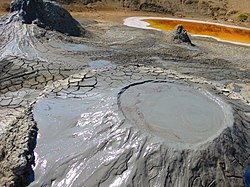Mud volcanoes in Azerbaijan



Azerbaijan has the most mud volcanoes of any country, spread broadly across the country. 350 of the 700 volcanoes of the world are in the Azerbaijani Republic.[1] Local people call them “yanardagh” (burning mountain), “pilpila” (terrace), “gaynacha” (boiling water) and “bozdag” (grey mountain).
Description
[edit]Underground and submarine mud volcanoes are famed in Azerbaijan. There are more than 140 submarine volcanoes in the Caspian Sea. Eight islands in the Baku Archipelago are mud volcanoes in origin. The other kind of mud volcanoes are wells. Their activity can be observed among strata of various ages.

About 200 eruptions have occurred in 50 volcanoes in the region since 1810. Eruptions are accompanied by strong explosions and underground rumbling. Gasses come out from the deepest layers of the earth and immediately ignite, with flames reaching 1,000 meters at the Garasu volcano. The Toragay volcano erupted six times from 1841 to 1950.
Mud volcanoes are associated with oilfields. Rich oil and gas fields are found in the territories of mud volcanoes (Lokbatan, Garadagh, Neft Dashlari, Mishovdagh and others). NASA geologists studying the planet Mars concluded that Azerbaijan's mud volcanoes have a similar structure to the uplands of Mars.
The eruptions of volcanoes are used as raw material in the chemical and construction industries as well as in pharmacology. In 2007, the State Natural reserves were created, covering the Absheron Peninsula.[2]
Volcanoes
[edit]The Gotur Dag volcano, located 70 km from Baku, is 150 m (492 ft) tall with a depth of 20 m (66 ft). Its last eruptions occurred in 1966 and in 1970. The overall volume of breccia is about 530×106 m3 (19×109 cu ft).
Bahar volcano is located 55 km from Baku, with a height of 45.0 m (147.6 ft). The last eruption was detected in 1993. Lokbatan volcano is located 15.0 km (9.3 mi) from Baku. Several eruptions from the 19th century were detected; the last eruption was in 2001.[3][4]
The Ayranteken volcano can be considered as the most active volcano in Azerbaijan. Located 65 km from Baku, many eruptions are accompanied by underground explosions and huge flames. The volcano reaches 190 meters. Its first eruptions are dated 1964 up to 1990.[4] Near the volcano, 800m length cracks can be found. Breccia of this volcano covers 805 hectares.
The September 23, 2018, eruption of Otman Bozdag reached 4 km long with cracks as deep as 80 m.[5][6] The last eruption of the Moose volcano occurred in 1970. Flames reached up to 1 km in height. Local earthquakes were felt.[7]
On July 4, 2021, at 21:51, an 8-minute long mud volcano eruption on Dashli ada in the Caspian Sea, located 10 km from an oil platform off the coast of Azerbaijan, caused a massive explosion and fireball, which was seen across the region, including from Baku, 74 km to the north. The flames towered 500 meters into the air.[8][9][10] There were no reports of injuries or damage to any oil platforms. It was speculated to either have been the eruption of a mud volcano, or the explosion of a gas pipeline. However, scientists confirmed that the explosion came from a mud volcano called 'Makarov Bank', and occurred near the Umid gas field, where there are both gas pipelines and natural pockets of compressed gas, as are commonly found in the Caspian Sea.[11][12] The last previous volcanic eruption on the island was recorded in 1945 and the preceding one in 1920.[13]
References
[edit]- ^ "Mud Volcanoes of Azerbaijan". Atlas Obscura. Retrieved 2020-02-10.
- ^ "Грязевые вулканы Азербайджана претендуют на "Семь чудес света"". Trend.Az (in Russian). 2009-07-23. Retrieved 2019-07-19.
- ^ "Azeri mud volcano flares". 2001-10-29. Retrieved 2019-07-19.
- ^ a b "ГРЯЗЕВОЙ ВУЛКАНИЗМ И ЗЕМЛЕТРЯСЕНИЯ" (PDF).
- ^ "Vulkan püskürən ərazidə çatların dərinliyi 80 metrə çatdı". Oxu.az. 2018-09-23. Retrieved 2018-09-24.
- ^ "Vulkan püskürən ərazidə çatların dərinliyi 80 metrə çatıb". Bizimyol. 2018-09-23. Retrieved 2018-09-24.
- ^ "Извержения грязевых вулканов". CollectedPapers (in Russian). 2015-06-15. Retrieved 2019-07-19.
- ^ "Azerbaijan Mud Volcano Erupts in Fiery Display". Smithsonian Magazine. 2021-07-07. Retrieved 2021-07-07.
- ^ "Press conference on incident in the Caspian Sea-VIDEO". Apa.az. Retrieved 2021-07-05.
- ^ "Azerbaijan says "mud volcano" caused Caspian Sea explosion". The Guardian. 2021-07-05. Retrieved 2021-07-05.
- ^ "Strong Explosions Lit Up the Night Sky Near Gas Field in Azerbaijan". Interestingengineering.com. 2021-07-05. Retrieved 2021-07-08.
- ^ "Blast rocks Caspian Sea area near Azerbaijani gas field". Washington Post. ISSN 0190-8286. Retrieved 2021-07-08.
- ^ "Mud volcanoes explained as huge explosion rocks the oil-rich Caspian Sea". Newsweek. 2021-07-05. Retrieved 2021-07-05.
External links
[edit]- Грязевые вулканы Азербайджана — одно из 7 новых чудес природы
- О природе грязевых вулканов. Профессор В. Н. Холодов. Геологический институт РАН, Москва
- Координационный Совет Азербайджанской Молодежи
